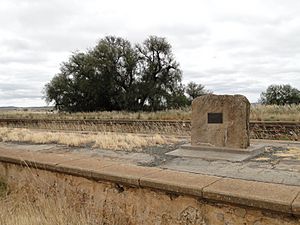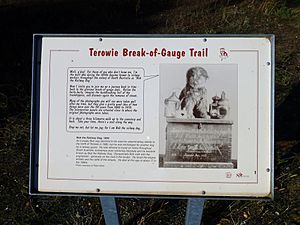Terowie, South Australia facts for kids
Quick facts for kids TerowieSouth Australia |
|||||||||||||||
|---|---|---|---|---|---|---|---|---|---|---|---|---|---|---|---|

Main Street, Terowie
|
|||||||||||||||
| Postcode(s) | 5421 | ||||||||||||||
| Elevation | 534 m (1,752 ft) | ||||||||||||||
| Location |
|
||||||||||||||
| LGA(s) | Regional Council of Goyder | ||||||||||||||
| Region | Yorke and Mid North | ||||||||||||||
| County | Victoria Kimberley |
||||||||||||||
| State electorate(s) | Stuart | ||||||||||||||
| Federal Division(s) | Grey | ||||||||||||||
|
|||||||||||||||
| Footnotes | Adjoining localities | ||||||||||||||
Terowie, once known as Gottliebs Well and Shebbear, is a small town in South Australia. It's about 220 kilometers (137 miles) north of Adelaide, the state capital. This historic town is part of the Regional Council of Goyder.
Terowie is special because it still has many original buildings from the 1880s. Because of this, it has been named a "historic town." It's a popular spot for people who love photography, history, and trains.
Contents
Terowie's Early Days and History
The name Terowie comes from an Aboriginal word. It means "hidden waterhole," and it was first used for Terowie Creek.
From Gottliebs Well to Terowie
Before the 1870s, the area was mostly known as Gottlieb's Well Station. This was a very large sheep farm, or pastoral property. It started in the 1840s. By the 1860s, it covered 407 square miles and had 40,000 sheep.
The main farm building at Gottliebs Well was busy. It also served travelers and stagecoaches. This spot was a few kilometers southwest of where Terowie town is today.
In the 1870s, many large farms in South Australia were divided into smaller pieces. This led to the area being called the Hundred of Terowie. In 1918, during World War I, Gottliebs Well was renamed Parnggi Well. This was because of strong feelings against German names at the time.
How Terowie Town Began
The town of Terowie was started around 1875 by John A. Mitchell. He built a public house (a type of hotel) which made a lot of money. This was because it was close to the Inkermann mine. Soon, other businesses like a blacksmith, a doctor, and a store opened.
By the end of 1875, there were seven houses in a row. In 1877, the government planned a town called "Shebbear" nearby. But people preferred the name Terowie. By 1880, Terowie had two stores, two butchers, a bakery, and three blacksmiths. It also had two hotels, two chapels, and the railway station. The railway line from the south was finished on October 11, 1880.
Historic Places in Terowie
Terowie has several sites that are protected for their history. These include:
- Main Street: ES&A Bank Building
- Main Street: Terowie General Store
- Main Street: Terowie Hotel
- Besanko Street: Terowie Oval Staging Camp Cell Block
- Railway Terrace: Terowie railway station
Terowie's Railway Story
Terowie became important because it was a transport hub in the late 1800s. It helped connect the northern parts of the state.
The Break of Gauge
Terowie was famous for its "break of gauge" on the railway. This means that trains coming from the south used a broad gauge track. But trains going north to Peterborough used a narrow gauge track.
So, all goods and passengers had to be moved from one train to another in Terowie. This made the town very busy for many years. Lines from places like Perth, Alice Springs, Broken Hill, and Sydney all connected through Peterborough.
In the 1970s, the broad gauge line was extended to Peterborough. This meant trains no longer needed to stop and change in Terowie. The town became much quieter. The railway line was removed in the early 1990s. However, many old railway items are still preserved in a museum and along a walking trail.
In 1898, when the town was a busy railway hub, about 800 to 900 people lived there. Many of them worked for the railways.
Terowie During World War II
Terowie was also a busy camp during World War II. This was because of the railway break-of-gauge. Many soldiers and supplies traveled through Terowie on their way to northern Australia.
Town's Height Above Sea Level
Terowie is located about 534 meters (1,752 feet) above sea level.
Famous People and Stories
Terowie has a few interesting connections to famous people and animals.
J.P. McGowan, Filmmaker
J.P. McGowan, a pioneering Hollywood filmmaker, was born in Terowie in 1880. His father worked on the railways. People think McGowan's lifelong interest in steam trains in his films might have started from seeing them in busy Terowie.
General Douglas MacArthur's Promise

On March 20, 1942, during World War II, a very important event happened in Terowie. Douglas MacArthur, a United States General, was changing trains there. He was interviewed by journalists from an Adelaide newspaper.
MacArthur had just left the Philippines. He told the journalists: "The President of the United States ordered me to break through the Japanese lines and proceed from Corregidor to Australia for the purpose... of organising an American offensive against Japan... I came through and I shall return."
The next morning, the newspaper printed his words under the headline: "I Shall Return." MacArthur used this phrase many times until he returned to Manila in February 1945. A plaque at the Terowie railway station remembers this moment.
Bob the Railway Dog
Bob, also known as Terowie Bob, was a famous dog who lived in Terowie. He first lived with Seth Ferry, who was a Special Porter at the railway station.
Bob is remembered in Terowie with special information boards. These boards make up the "Bob the Railway Dog Trail" at different interesting spots in the town.
Images for kids
-
Portion of the remains of the Terowie railway station












